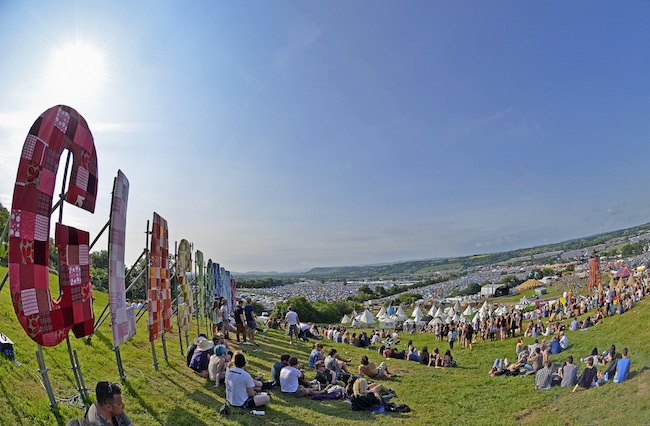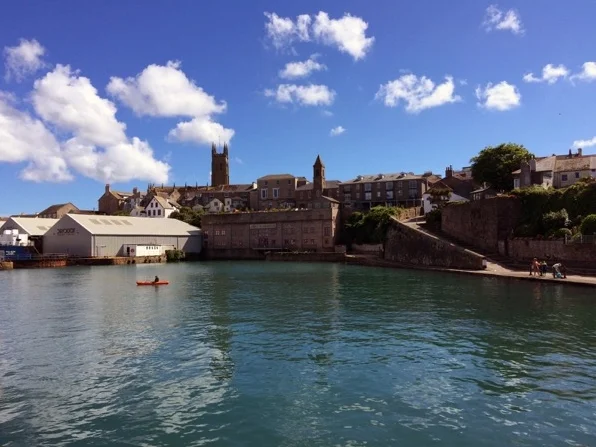All Elyn Aviva wanted was a quiet, peaceful vacation in a rented cottage in Penzance, Cornwall. Noise, traffic, and a lack of privacy was what she got instead. Ready to call it quits and return home, she creates a mental trick that helps her to endure. Until it doesn't.
All tagged England
Looking for Gratitude on the Cornish Saints Way
Not every trip goes as planned. When writer Elyn Aviva and her husband embark on a pilgrimage of gratitude, unexpected obstacles reveal even more reasons to be grateful.
Brexit: A View from Inside England
American expats, Gary White and his wife Elyn Aviva traveled from Spain to the UK for a vacation and found themselves in the middle of a festival and the big Brexit vote and aftermath.
Misled on St Michael’s Way, Cornwall
by Elyn Aviva
It took nearly 11 years and three attempts for my husband, Gary, and me to complete the 12-mile-long St Michael’s Way across the southern tip of Cornwall. That’s a rather long time for a short walk—probably a record of some sort. And even though we ended up hiking more than 12 miles, we never did manage to walk the middle five.
But we persevered, although we were misled every step of the way.
My husband, Gary, and I recently went to Cornwall to walk meandering paths with a small group. At least, thatwas the story. One morning over breakfast at Rosemerryn House in Lamorna Valley, one of our group revealed she is a professional storyteller. She described learning to take storytelling seriously. “After all,” she mused, “We don’t usually think stories are important. At least, not in the real world.”
I realized that often the word “story” is used as a code word for “false.” As in: “Oh, that’s a likely story! You don’t really expect me to believe you, do you?” Or it’s trivialized to mean something soothing, as in, “Tell me a bedtime story.” Of course, a story is much more than that: it is how we make meaning out of our experiences—as in, “telling the story of my life.” Sometimes I identify so much with my story that instead of me telling “it,” it starts telling “me.”
Pendeen Fogou wasn’t a very prepossessing site. To reach it, the three of us—my husband, Gary, our guide, Cheryl Straffon, and I—had to unfasten three rusty metal gates to venture ever deeper into a farmer’s cattle yard. The broken concrete beneath our feet was covered with several layers of dried (or drying) cow manure. Cattle were lowing and resting in their own muck in the nearby pens.
Our goal was a six-foot-tall stone structure with tall grasses and weeds growing out of the top and a yawning opening in one wall. Before we could enter the site, we had one more obstruction: a detached farm gate, which the three of us hauled over to one side.
Bending low, we followed Cheryl down a steep, stone-lined passage deep into the earth. I was grateful I had my hiking staffs to help keep me from slipping. At the bottom, the rocky passage leveled out. My flashlight illuminated moss-covered granite walls and ceiling, the large stones carefully placed to construct the fogou. Pronounced “foo-goo,” it’s a Cornish word that means “cave,” and it refers to a human-made underground cavern.
The year is 1645. The most virulent strain of the Bubonic Plague has immobilized Edinburgh, Scotland, claiming the lives of more than half the city’s population. The area hardest hit: Mary King’s Close on High Street, a busy thoroughfare and lively 17th century street of pubs, shops and residences. Cries of suffering have replaced the friendly chatter, and the stench of death, the pungent aroma of tea and scones.
The place, the time, the horror have been resurrected as one of Edinburgh's most unusual attractions. Archaeologically and historically accurate, the alleys you walk upon, the rooms you visit, the stories you hear are real. This is not a recreation; it is a resurrection of what already existed so many centuries ago.
Beneath the City Chambers on Edinburgh’s famous Royal Mile, lies Mary King’s Close, a series of narrow, winding side streets with multi-level apartment houses looming on either side, which has been hidden for many years. In 1753, the houses at the top of the buildings were knocked down to make way for the then-new building. Parts of the lower sections were used as the foundation, leaving below a number of dark and mysterious underground alleyways steeped in mystery -- and misery.
Would You Eat Your Lunch in a Cathedral?
Musing at Scorhill Stone Circle, England by Elyn Aviva
We trudged up the bleak hill, brown and barren. My husband, Gary, and I were hiking with a small group in desolate, wild Dartmoor National Park to a place we’d never been, following a faint path through the moor, a track barely visible in the water-logged, peaty soil. Our guide informed us that people can easily lose their way on the moors—experienced hikers, skilled in reading maps, disappear, their bodies found years later.
My Journey to the Union of Heaven and Earth
by Elyn Aviva
Join me on a journey into the unknown, where what you think you know melts away and is replaced by something bigger.
My Journey to the Union of Heaven and Earth
by Elyn Aviva
Join me on a journey into the unknown, where what you think you know melts away and is replaced by something—something “bigger.”
For decades I have been drawn to sacred sites and powerful places, drawn to go on pilgrimage across France and Spain, drawn to place my feet in the footsteps of if not my ancestors then of the ancestors of spirit who have traveled these paths before me. Like iron pulled toward a magnet, I have sought out well- and little-known places of power—ancient stone circles, half-buried dolmens, ruined Romanesque chapels, spire-topped inspiring cathedrals, thick forests, hidden holy wells, dark sacred caves. Seeking I knew not what, going I knew not why, except that I was driven by a simple but all-consuming question: “What are these places?” I think I hoped that, by going to enough of them, I would find the answer.
Falling in Love with Wells Cathedral
by Elyn Aviva
I never thought I’d fall in love again. And certainly not with a building! Yet there I was, heart pounding, eyes damp at the sight of her.
Funny how the first few times I’d seen her, I never felt this “hit” of passionate connection. But that’s often how love strikes us, isn’t it? Not much interest at first—but then, Pow! Like a thunderbolt.
by Elyn Aviva
Welcome to Ynys-witrin, the Island of Glass, AKA “Glasto,” thriving spiritual theme park for the New Age, neo-pagans, witches, traditional Catholics, Anglicans, Buddhists, Hindus, Methodist church ladies, sound healers, shamanic journey-ers, light therapists, Arthurian aficionados, Isle of Avalon pilgrims, holy-well-water visitors, Grail seekers, and recovering addicts. If that makes your head buzz, it should. And that ain’t the half of it.
 Glastonbury Park 2013. Photo by jaswooduk.
Glastonbury Park 2013. Photo by jaswooduk.
We had decided to spend a month in Glastonbury. It had seemed like a good idea at the time—which should have been a warning signal. A month in Glastonbury? A town where every time we had visited for a few days we shook our heads and said, “NOT a place to stay for very long! Too intense, too ungrounded…” But somehow, in a moment of inspired weakness, it seemed like a good idea. Get away from our apartment in Girona (Catalonia, Spain) where we couldn’t seem to get away from work. Rest and relax in a rural Somerset town where we could go for gentle walks up to the scenic tower on top of the 500-foot high, dragon-backed Tor hill, or visit the lush and lovely Chalice Well Gardens, or stroll through the extensive grounds of the ruined but still evocative Glastonbury Abbey.
Genuine or Hoax? Visiting a Crop Circle Formation at Avebury, England
by Elyn Aviva
The news rippled through our group like a breeze through a wheat field: a crop circle had just been spotted! According to a crop circle blog, it had appeared only two days earlier, on the side of Windmill Hill, close to Avebury, in southern England. We were told it was still fresh and relatively untrammeled. Even better news was that we were nearby, since our group was visiting sacred sites in the area—including Stonehenge, Glastonbury, and Avebury, site of the largest stone circle in the UK.
Crop formations usually occur in fields of ripe cereal grains. They appear all over the world but are most prevalent during July and August in the Wiltshire district of southern England. The complex patterns range in size from just a few feet across to over 900 feet, although the average is about 200-300 feet in diameter, and they vary in elements from a few to over 400. The designs may be circular (hence “crop circle”) or based on other geometrical forms (hence “crop formation”).








